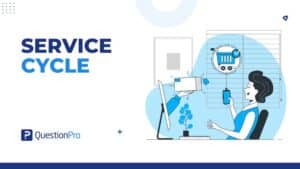
Feedback serves as a crucial mechanism for improvement and growth. Whether a customer shares their experience with a product or service or an employee offers insights on company processes, feedback provides invaluable information that organizations can use to refine their offerings and enhance their operations. At the heart of this process lies the concept of a feedback loop.
Feedback loops aren’t just about collecting opinions—they’re about turning those insights into actions that make a real difference. So, whether you’re a customer providing feedback or a business listening and responding, remember that feedback loops are a collaborative effort to improve things for everyone involved.
In this blog, we’ll explore what exactly a feedback loop is, how it functions within organizations, and why it is important in achieving sustained success in today’s competitive market.
What is Feedback Loop?
A feedback loop is a process where the output of a system is used as input to the same system, creating a loop of information. It’s like a loop of information that keeps circulating and affecting the system’s behavior. This loop can be either positive or negative.
Feedback loops are essential in various systems, from biological processes in organisms to regulating economic markets and the functioning of technological systems. Understanding feedback loops helps us comprehend how systems behave and how they can be influenced or controlled.
Why Are Feedback Loops an Important Tool?
Feedback loops are crucial tools because they provide a mechanism for self-correction and adaptation within systems. Here’s why they’re important:
- Feedback Loop Maintain Stability: Feedback loops help systems maintain stability by providing a means to regulate and balance their behavior.
- It Improves Your Performance: Feedback loops enable systems to learn and improve over time. Systems can optimize their performance and achieve better results by continuously evaluating the output and adjusting the input based on that evaluation.
- Feedback Loop Helps to Adapt the Changes: Feedback loops allow systems to adapt to changes or disturbances. They provide a way for systems to detect shifts in conditions and respond accordingly.
- It Facilitates Innovation: Feedback loops foster innovation by providing a means for experimentation and iteration. They enable systems to try new approaches, observe the outcomes, and adjust accordingly.
Types of Feedback Loop
Feedback loops are fundamental mechanisms that play crucial roles in various systems. Here are two main types of feedback loops: positive and negative.
Positive Feedback Loops
A positive feedback loop in a company involves listening to employees’ complaints and suggestions and using that feedback to enhance internal structure and workplace satisfaction. This improved employee happiness, which, in turn, contributes to increased profitability for the company.
Positive feedback mechanisms can take various forms, formal or informal, where employee feedback on overall work satisfaction is collected and used to implement changes that boost employee morale and satisfaction.
Positive Feedback Loop Examples
One of your valued customers recently had a fantastic experience with your customer service team. After the interaction, they left glowing feedback through your survey.
The Feedback Loop
As the owner of the coffee shop, here’s how you can handle this positive feedback to ensure continuous improvement and recognition within your team:
- Express Gratitude Toward the Customer
Thank the customer for their feedback and let them know that you will share their positive comments with the specific customer service agent who assisted them.
Negative Feedback Loop
A negative feedback loop describes how a company listens to customers’ complaints or grievances and utilizes that feedback to enhance its products or customer service. This iterative process uses customers’ feedback (output) as constructive input to redesign its products, forming a continuous improvement cycle.
This customer feedback loop is mutually beneficial for both businesses and customers. When their feedback is acknowledged, customers feel valued and respected, increasing the likelihood of becoming long-term advocates for the brand. Simultaneously, the business refines its designs to enhance customer satisfaction and loyalty.
Negative Feedback Loop Examples
A customer recently contacted your coffee shop’s customer service team with a complaint. After the interaction, they provided detailed feedback through the survey you sent them, outlining their dissatisfaction with the service they received.
The Feedback Loop:
As the owner of the coffee shop, here’s how you can handle this negative feedback to turn it into an opportunity for improvement and growth:
- Thank the customer for their feedback, apologize, and assure them their concerns are noted. Investigate whether the issue is isolated or part of a trend. Discuss the incident with the involved agent and provide feedback. Develop and implement an action plan, including training. Monitor improvements through follow-up surveys and reviews. Recognize and reward your team for improvements.
How Does Feedback Loop Work?
Feedback loops are essential mechanisms that enhance performance and productivity within organizations. For feedback loops to be effective, they rely on transparent and open communication, clear processes, and the right tools. Here’s how they work:
1. Provide Transparent and Open Communication
Feedback loops thrive in environments where communication is clear and open. This means creating a culture where employees feel comfortable expressing their opinions, both positive and critical. Open communication also involves a willingness to receive feedback without defensiveness, fostering a climate system of trust and mutual respect.
Key aspects of transparent communication in feedback loops include:
- Specificity: Feedback should be detailed and clear about what is being addressed.
- Actionability: Feedback should provide clear steps or actions that can be taken.
- Timeliness: Feedback should be given promptly to ensure relevance and immediacy.
When communication is transparent and open, feedback loops can effectively drive positive changes, identify areas for improvement, and strengthen connections within the organization.
2. Automate Your Feedback Processes
Collecting and analyzing feedback manually can be labor-intensive. Automated systems help streamline this process, making it more efficient and responsive. Automation tools can capture and analyze feedback from customers and employees quickly, allowing for immediate action.
Methods to automate feedback processes include:
- Survey Software: Automatically send out surveys and collect responses.
- Chatbots: Gather real-time feedback through automated interactions.
- Integration with CRM and Analytics Platforms: Facilitate seamless tracking and analysis of feedback data.
Automation reduces the burden on the customer service team, mitigates risks, ensures quick responses, and prevents issues from escalating.
3. Choose the Appropriate Channels
The effectiveness of feedback loops depends on selecting the right channels to collect feedback. This choice should consider the target audience, the type of feedback desired, the required level of detail, and cost constraints.
Considerations for selecting channels include:
- Audience Targeting
- Feedback Type
- Detail Level
- Cost
Surveys, interviews, focus groups, social media, and customer support platforms are suitable channels for feedback loops.
4. Integrate Your Feedback into Strategic Planning
Feedback loops must be integrated into strategic planning to contribute to sustainable growth. By incorporating customer and employee insights, businesses can develop responsive and forward-thinking strategies, directing resources efficiently to meet genuine needs and opportunities.
5. Categorize Feedback to Manage Effectively
Segment feedback based on its source, relevance, and impact to manage feedback effectively. Prioritize feedback from loyal customers, high-value clients, or employees with critical expertise. Additionally, feedback can be categorized by the customer journey stage or organizational department.
6. Quantitative vs. Qualitative Feedback
Different types of feedback offer unique insights. Quantitative feedback, such as survey ratings and analytics, provides statistical trends, while qualitative feedback, like comments and suggestions, offers depth and context. Balancing both types of feedback is crucial for a comprehensive analysis.
7. Ensure Consistency and Repetition
Identify recurring themes and patterns in feedback. Feedback that is consistently mentioned across various sources or over time is likely more significant and valuable.
8. Acknowledging and Rewarding Feedback
Acknowledging and rewarding feedback shows that contributions are valued, encouraging continued participation. Methods to acknowledge feedback include:
- Thank the individual for their input.
- Highlight how their feedback was helpful.
- Acknowledge efforts in a public forum.
- Offer rewards such as gift cards or certificates of appreciation.
By following these principles, feedback loops can function effectively, driving continuous improvement and fostering a culture of openness and responsiveness within the organization.
How to Close the Feedback Loop with QuestionPro
Closing the feedback loop with QuestionPro involves a systematic approach to ensure that customer feedback is collected and acted upon effectively. Here’s a detailed guide on how to achieve this:
Allow to Collect Your Feedback
QuestionPro offers robust survey tools across various channels, such as
- Web
- Mobile apps
- Social media platforms
You can implement mechanisms like in-app surveys or website pop-ups to capture immediate customer sentiments and reactions. You can also set up automated surveys triggered by specific customer interactions or milestones in their journey to gather continuous feedback effortlessly.
Analyze Your Feedback
You can integrate feedback data from QuestionPro with your CRM system or analytics platforms for a centralized view of customer insights. QuestionPro’s advanced analytics tools are used to analyze trends and actionable insights.
- quantitative metrics (ratings, scores) and
- qualitative feedback (comments, suggestions)
It helps to identify trends and actionable insights. Segment feedback based on demographics, behavior, or feedback type to prioritize actions and responses effectively.
Take Action for Improvement
Explore QuestionPro to identify key themes and actionable insights from feedback that align with improving customer experience or resolving issues. QuestionPro offers:
- Create Action Plans: Develop clear action plans with specific steps and timelines to address identified issues or capitalize on opportunities highlighted by customer feedback.
- Use Ticketing System: Utilize QuestionPro’s ticketing system to assign tasks to relevant teams or individuals, ensuring accountability and tracking progress.
Implement Changes for Ongoing Insight
This platform ensures the timely execution of action plans by communicating responsibilities clearly and monitoring progress through management tools. Continuously monitor the implementation of changes, gather further feedback, and adjust strategies as needed based on ongoing insights.
Close the Loop
You can immediately acknowledge receipt of customer feedback to demonstrate responsiveness and value for their input with QuestionPro. You can inform customers about the actions taken in response to their feedback. Personally follow up with customers who provided feedback, especially those who raised concerns, to ensure their issues are resolved satisfactorily.
Review and Improve
QuestionPro allows assessing the impact of implemented changes on customer satisfaction metrics and business outcomes. It offers analytics and follow-up surveys to gauge customer perception post-implementation. Continuously refine your feedback loop process based on insights gathered.
Use QuestionPro’s reporting features to generate detailed reports summarizing feedback findings, actions taken, and outcomes achieved. Share success stories and positive outcomes resulting from customer feedback initiatives internally. Celebrate achievements and recognize team efforts in driving customer-centric improvements.
Conclusion
A feedback loop is a powerful tool for any organization looking to grow and thrive. By actively listening, analyzing, and acting upon feedback, businesses can continuously improve and adapt to meet the ever-changing needs of their customers and stakeholders. Embracing a feedback-driven culture enhances product and service quality and builds stronger connections with the community it serves.
Utilizing tools like QuestionPro streamlines this process, from collecting diverse feedback sources to analyzing actionable insights and implementing meaningful changes. Remember, a robust feedback loop builds customer loyalty and propels organizational growth and success in today’s dynamic market. Contact QuestionPro to learn more!







